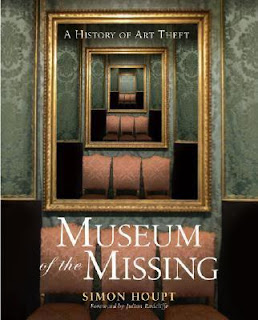
By now the world is well aware of the May 20, 2010 art heist in which five paintings (by Picasso, Matisse, Modigliani, Leger and Braque) valued at over 100€ million were stolen from the Musée d'Art Moderne in Paris. The method of the heist appears to have been quick and unsophisticated. In less than 15 minutes a thief, clad in black, entered the museum by breaking windows, smashing a padlock, and then cut the canvases free from their frames. Despite the apparent simplicity of the robbery, within hours Interpol, the world’s largest international police organization, had alerted its 188 member countries of the theft, indicating the potential speed and sophistication with which stolen works can be moved throughout the world.
This disconnect between a thuggish-style theft and the complex worldwide network of stolen art begs with the question, what type of criminal steals paintings and what becomes of the stolen artwork? Simon Houpt’s book,
Museum of the Missing: A History of Art Theft, explores this question through chapters devoted to topics such as the commodity of art, art theft during wartime, profiles of art criminals, and the business of museum security and theft investigation.
Houpt speculates: “There may be as many different sorts of art ‘nappers’ as there are schools of painting. Inside jobs are pulled off by resentful security guards trying to humiliate their bosses, poorly paid servants looking for a retirement nest egg, attention seeking children of rich collectors, and museum staff who fall for a thing of beauty tucked away in storage and decide to take full advantage of deficient record keeping. The ‘perp’ may be a mere street thug with a bad back who realizes that a couple of canvasses are easier to lift than a truckload of electronics. Insurance adjusters and authorities increasingly believe that underworld crime figures use art as collateral for drugs and other illicit goods.”
Houpt interviews Robert K. Wittman, a special agent with the art crime team of the FBI (and author of
Priceless: How I Went Undercover To Rescue The World's Stolen Treasures), who says that when it comes to profiling art thieves, "we haven't found a common thread at this point.”
Beyond chapters exploring facets of the underground world of stolen art, the concept of the "museum of the missing" is a compelling metaphor to visualize. The book’s introduction describes the Dutch Room of Boston’s Isabella Stewart Gardner Museum, where within, resting atop an easel is a canvas-less gilded frame covered over a heavy brown cloth. Until its theft in 1990, the frame contained Vermeer’s
The Concert, one of only 36 known works by the master painter. In addition to this painting, a museum of the missing would contain over one hundred and fifty Rembrandts, five hundred Picassos, and innumerable works by Raphael, Titian, Degas, Monet, etc.
Presently, there are over 200,000 art objects listed through the
Art Loss Register. Houpt’s appendix offers a selected tour of missing works and the fascinating stories of their theft, such as the inconceivable heist of Reclining Figure LH608, a bronze, two-tonne Henry Moore sculpture thought to have been melted down for scrap metal.
Further library reading on this topic can be found both in Library's General Collections & Humanities Center on the 3rd floor and the Art, Music & Recreation Center on the 4th floor.
Rogues in The Gallery: The Modern Plague of Art Thefts, published before the infamous Gardner theft of 1990, highlights equally large robberies beginning with the 1911 theft of the Mona Lisa. While the outcome of many cases has changed since its publication, the work documents several forgotten heists.
Sotheby's: The Inside Story is an expose of the questionable, if not outright illegal, practices of one of the world’s most famous art and antiquities auction houses. Archival documents supplied by a former Sotheby’s antiquities administrator substantiate the author’s claims.
Loot: The Battle Over The Stolen Treasures of The Ancient World focuses on stolen antiquities, offering a tour of some of the world's finest museum holdings and the countries from which their artifacts were illicitly taken. Museum rights and ethics are discussed.
Two essential websites are the blog
Art Theft Central and the
Art Loss Register.
In the realm of feature films there is
Dr. No which includes a shot of James Bond sighting Goya's portrait
The Duke of Wellington on the walls of Dr. No's den. When the film came out in 1962, this painting was in fact missing, having been stolen from London’s National Gallery the prior year. Other films include
Entrapment,
The Maiden Heist, and
The Maltese Falcon.
Bibliography:Loot: The Battle over The Stolen Treasures of The Ancient World by Sharon Waxman (Times Books, 2008).
Museum of The Missing: A History of Art Theft by Simon Houpt (Sterling Pub., 2006).
Priceless: How I Went Undercover To Rescue The World's Stolen Treasures by Robert K. Wittman with John Shiffman (Crown Publishers, 2009).
Rogues in The Gallery: The Modern Plague of Art Thefts by Hugh McLeave (D. R. Godine, 1981).
Sotheby's: The Inside Story by Peter Watson (Random House, 1997).
Related blog entry: Purge and Plunder: Art under The Third Reich [September 3, 2009]
 Memory Jacket designed by Linda Watson, Artist, Second hand Levi jacket with embellishments - on display in the Art, Music and Recreation Center, 4th floor, Main Library
Memory Jacket designed by Linda Watson, Artist, Second hand Levi jacket with embellishments - on display in the Art, Music and Recreation Center, 4th floor, Main Library Through its Green Stacks programming, the Library is committed to providing information on green living through its resources and its programs. One such event will take place on Saturday June 19 from 12:00 to 4:00 at the Main Library. A free class called Recycled Clothing: Creating New From Old will help participants create “new one-of-a-kind works of wearable art.” Call (415) 557-4400 for more information.
Through its Green Stacks programming, the Library is committed to providing information on green living through its resources and its programs. One such event will take place on Saturday June 19 from 12:00 to 4:00 at the Main Library. A free class called Recycled Clothing: Creating New From Old will help participants create “new one-of-a-kind works of wearable art.” Call (415) 557-4400 for more information. For those interested in this topic, but unable to attend the Saturday class, the Library has plenty of books filled with inspiring and innovative ways to refashion any wardrobe. A few are listed below:
For those interested in this topic, but unable to attend the Saturday class, the Library has plenty of books filled with inspiring and innovative ways to refashion any wardrobe. A few are listed below:






